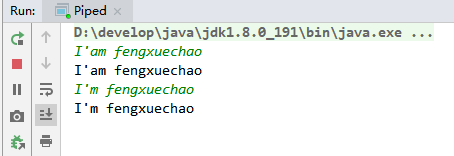Java 并发学习记录之线程间通信
volatile 和 synchronized 关键字
Java并发学习记录之volatile
Java并发学习记录之synchronized
等待/通知机制
Java并发学习记录之wait-notify机制
管道输入/输出流
管道输入/输出流和普通文件的输入/输出流或者网络输入、输出流不同之处在于管道输入/输出流主要用于线程之间的数据传输,
而且传输的媒介为内存。
管道输入/输出流主要包括下列两类的实现:
- 面向字节: PipedOutputStream、 PipedInputStream
- 面向字符: PipedWriter、 PipedReader
1
2
3
4
5
6
7
8
9
10
11
12
13
14
15
16
17
18
19
20
21
22
23
24
25
26
27
28
29
30
31
32
33
34
35
36
37
38
39
40
41
42
43
44
45
46
47
48
49
50
51
52
53
54
55
56
57
58
59
60
61
62
63
64
| package com.littlefxc.examples.base.thread.pipe;
import java.io.IOException;
import java.io.PipedReader;
import java.io.PipedWriter;
public class Piped {
public static void main(String[] args) throws IOException {
PipedWriter writer = new PipedWriter();
PipedReader reader = new PipedReader();
writer.connect(reader);
Thread printThread = new Thread(new Print(reader), "PrintThread");
printThread.start();
int receive = 0;
try {
while ((receive = System.in.read()) != -1) {
writer.write(receive);
}
} catch (IOException e) {
e.printStackTrace();
} finally {
writer.close();
}
}
static class Print implements Runnable {
private PipedReader reader;
public Print(PipedReader reader) {
this.reader = reader;
}
@Override
public void run() {
int receive = 0;
try {
while ((receive = reader.read()) != -1) {
System.out.print((char) receive);
}
} catch (IOException e) {
e.printStackTrace();
}
}
}
}
|
运行该示例,输入一组字符串,可以看到 printThread 进行了原样输出。

Tips:
对于 Piped 类型的流,必须要进行绑定,也就是调用 connect(),否则会抛异常。
Thread.join() 的使用
在很多情况下,主线程生成并起动了子线程,如果子线程里要进行大量的耗时的运算,
主线程往往将于子线程之前结束,但是如果主线程处理完其他的事务后,需要用到子线程的处理结果,
也就是主线程需要等待子线程执行完成之后再结束,这个时候就要用到join()方法了。另外,
一个线程需要等待另一个线程也需要用到join()方法。
Thread类除了提供 join() 方法之外,还提供了 join(long millis)、join(long millis, int nanos)
两个具有超时特性的方法。这两个超时方法表示,如果线程thread在指定的超时时间没有终止,
那么将会从该超时方法中返回。
重点看一下 join(long millis) 的示例:
1
2
3
4
5
6
7
8
9
10
11
12
13
14
15
16
17
18
19
20
21
22
23
24
25
26
27
28
29
30
31
32
33
34
| package com.littlefxc.examples.base.thread;
public class JoinLongTest {
public static void main(String[] args) {
try {
MyThread threadTest = new MyThread();
threadTest.start();
threadTest.join(1000);
System.out.println("主线程结束");
} catch (InterruptedException e) {
e.printStackTrace();
}
}
static public class MyThread extends Thread {
@Override
public void run() {
try {
Thread.sleep(2000);
System.out.println("子线程结束");
} catch (InterruptedException e) {
e.printStackTrace();
}
}
}
}
|
运行结果:

ThreadLocal
之前我们讲保证线程资源安全问题时,使用同步加锁的方式保证线程安全。还有一种办法就是隔离资源的做法。
所谓的隔离,即每个线程使用自己的局部资源。将资源隔离不让其它线程访问,
从被隔离资源的角度来说,能够访问它的只有当前线程。既然只有当前线程可以访问的数据,自然是线程安全的。
一个典型的例子就是 Servlet。
ThreadLocal 的简单使用
首先来一个不使用 ThreadLocal 的类,然后在逐渐对其改造。
1
2
3
4
5
6
7
8
9
10
11
12
13
14
15
16
17
18
19
20
21
22
23
24
25
26
27
28
29
30
31
32
33
34
35
36
37
38
39
40
41
42
43
44
45
| package com.littlefxc.examples.base.thread.threadlocal;
import java.text.ParseException;
import java.text.SimpleDateFormat;
import java.util.Date;
import java.util.concurrent.ExecutorService;
import java.util.concurrent.Executors;
public class ThreadLocal1 {
private static final SimpleDateFormat SDF = new SimpleDateFormat("yyyy-MM-dd HH:mm:ss");
public static void main(String[] args) {
ExecutorService es = Executors.newFixedThreadPool(10);
for (int i = 0; i < 1000; i++) {
es.execute(new ParseDate(i));
}
es.shutdown();
}
private static class ParseDate implements Runnable {
int i = 0;
public ParseDate(int i) {
this.i = i;
}
@Override
public void run() {
try {
ParseDateWithSync
Date date = SDF.parse("2019-02-26 16:23:" + i % 60);
System.out.println(i + ":" + date);
} catch (ParseException e) {
e.printStackTrace();
}
}
}
}
|
运行结果:

一般这种问题主要是因为 SimpleDateFormat 在多线程环境下,是线程不安全的,所以如果你在多线程环境中共享了SimpleDateFormat的实例,
比如你在类似日期类中定义了一个全局的 SimpleDateFormat 对象,这样子肯定会出现上述的报错
一种解决办法就是加锁,在上面代码中可以将注释去掉后再次运行,也就不会出现这个问题了。
但是我现在要使用保存线程局部变量的ThreadLocal对象来保存每一个线程的SimpleDateFormat对象,针对上述代码做出改变:
1
2
3
4
5
6
7
8
9
10
11
12
13
14
15
16
17
18
19
20
21
22
23
24
25
26
27
28
29
30
31
32
33
34
35
36
37
38
39
40
41
42
43
44
45
46
47
48
| package com.littlefxc.examples.base.thread.threadlocal;
import java.text.ParseException;
import java.text.SimpleDateFormat;
import java.util.Date;
import java.util.concurrent.ExecutorService;
import java.util.concurrent.Executors;
public class ParseDateWithThreadLocal {
static final String pattern = "yyyy-MM-dd HH:mm:ss";
private static final ThreadLocal<SimpleDateFormat> threadLocal = new ThreadLocal<SimpleDateFormat>();
public static void main(String[] args) {
ExecutorService es = Executors.newFixedThreadPool(10);
for (int i = 0; i < 1000; i++) {
es.execute(new ParseDate(i));
}
es.shutdown();
}
private static class ParseDate implements Runnable {
int i = 0;
public ParseDate(int i) {
this.i = i;
}
@Override
public void run() {
try {
if (threadLocal.get()==null) {
threadLocal.set(new SimpleDateFormat(pattern));
}
Date date = threadLocal.get().parse("2019-02-26 16:23:" + i % 60);
System.out.println(i + ":" + date);
} catch (ParseException e) {
e.printStackTrace();
}
}
}
}
|
注意:从上面代码中也可以看出,为每一个线程分配一个对象的工作并不是由 ThreadLocal 来完成的,
而是需要开发人员在应用层面保证的。ThreadLocal 只是起到了一个容器的作用。
ThreadLocal的原理
ThreadLocal的原理


